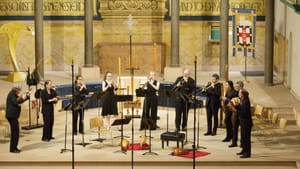Stay in the Loop
BSR publishes on a weekly schedule, with an email newsletter every Wednesday and Thursday morning. There’s no paywall, and subscribing is always free.
The life and travels of a king—and of Piffaro
Piffaro, the Renaissance Band presents The Musical Legacy of Charles V

This month, Philadelphia’s redoubtable Renaissance band gathered 10 stellar musicians for its season finale. But in addition to closing its 38th season, Piffaro’s latest concert (performed live in mid-May and streaming through May 31, 2022) also celebrated the legacy of Bob Wiemken and Joan Kimball, who founded the ensemble 40 years ago and have produced more than 140 of its concerts.
As is their practice, Piffaro impeccably presented thematic repertoire that was complex and highly structured, but totally comprehensible. Here, the ensemble explored music from the age of Charles V (1501-1558), beginning at his birth and ending with music commemorating his death. Alongside compositions from Europe, Piffaro’s usual focus, the group included works from Mexico, the “new world” providing musical (and actual) gold for monarchs across the sea.
The young emperor
Charles V held a bevy of titles—Lord of the Netherlands, King of Spain, and Holy Roman Emperor—and Piffaro’s concert was divided into eight sections that followed the chronology of his imperial career. To celebrate his birth, they opened with a lively procession of recorders and bagpipes from an anonymous suite of Flemish tunes (Charles was born in Flanders) that blossomed into nine works by famous-at-that-time composers Josquin Després, Antoine Busnois, Jakob Obrecht, Alexander Agricola, and Pierre de la Rue.
A duo for two lutes (Daniel Swenberg and Grant Herreid) titled “J’ay pris amours” (arranged by Herreid) was especially beautiful. And Priscilla Herreid and Joan Kimball were elegant on shawms (a double reed basic to Renaissance bands), rising over sackbuts (an early trombone whose name belies its mellifluous sound) played by Greg Ingles and Erik Schmalz.
When at the age of six Charles was proclaimed Lord of the Netherlands, Marguerite of Austria was appointed regent. During her tenure (until 1514), Marguerite supported an active cadre of musicians in the court chapel and collected secular manuscripts. Piffaro’s second set (from this era) featured four settings of the song “Mille regretz” with flute (Héloise Degrugillier), lutes, and douçaine (a mellow-sounding double reed instrument). Swenberg also played a quiet, affecting lute solo (a pavane by Tylman Susato) that seemed to travel directly from the 16th century.
Shawm, lute, and bagpipe
The concert’s third section was filled with celebratory music created when (at age 16) Charles was crowned King of Spain, opening with a rousing fanfare by the six-foot-long straight trumpets. Music in this section was elegant, regal, and particularly evocative of the period, including a majestic Després work for shawm ensemble (“Vive le roy”) and two sacred works by Cristóbal de Morales, the first Spanish composer of international renown whose influential music was often considered the most perfect of its time.
Next, a set of Italian compositions commemorated Charles’s coronation as Holy Roman Emperor (1530) by Pope Clement VII. These included an anonymous suite of 16th-century Italian dances opening with the charming “La Parma,” where two lutes were joined in turn by other instruments, including bagpipes played with aplomb by Kimball, no small feat considering the day’s humidity.
A wider world
After intermission, Piffaro explored the era’s wider political and musical world. “Plus oultre / More beyond" was a French work by Nicholas Gombert arranged by Grant Herreid for recorder consort. And there were striking works by Gaspar Fernandes, who began his career as a choirboy in Portugal and became chapel master at the Cathedral in Mexico City. Fernandes collected music (especially by de Morales) for use in American cathedrals, but he also composed a sizable number of villancicos, many intended for Christmas. Piffaro played two of these, including “Xicochi, xicochi conetzintle / Sleep, sleep little child,” a lovely instrumental chorale-like lullaby titled in the indigenous Nahuatl language.
The concert’s penultimate set commemorated the death of Charles V (1558), recreating the solemn occasion with two Morales works played at a well-documented 1559 commemorative service in Mexico City: the sobering “Agnus dei” and “Communio (Lux aeterna)” from Morales’s "Missa pro defunctis / Mass for the Dead" with interspersed Latin chant.
The concert ended with three intertwined works illustrating Charles’s musical legacy. "Elegit eum Dominus," Fernandes’s new-world processional for the Mexico City Cathedral, was followed by the elegiac "Fabordones del cuarto tono" by Antonio de Cabezón (a Spanish composer that played on both sides of the Atlantic) that featured solo passages for multiple instruments. And the final work (by Juan Arañés) featured the entire company in a chacona, a new world dance form that was imported back to Europe.
Still transporting the audience
At the opening of this expansive concert (available online through May 31), Wiemken announced that while this was a “life and travels of Charles V,” it was also a “life and travels of 40 years of Piffaro.” The ensemble almost magically transports its audience, evoking those long-ago ages with surprising immediacy, and this concert was imbued with the intensity, scholarship, and joy in Renaissance music that Wiemken and Kimball have brought to Piffaro. The duo announced that next season, Priscilla Herreid takes over artistic directorship of this storied ensemble.
What, When, Where
The Musical Legacy of Charles V. Music by composers from the 16th-century Hapsburg court. Ensemble members Joan Kimball, Bob Wiemken, Priscilla Herreid, Grant Herreid, Greg Ingles, and Erik Schmalz, with guest artists Georgeanne Baker, Héloise Degrugillier, Fiona Last, and Daniel Swenberg. Piffaro, the Renaissance Band. Live concerts May 13 through 15, 2022; recorded concert ($19) available virtually through May 31, 2022. (215) 235-8469 or piffaro.org
Sign up for our newsletter
All of the week's new articles, all in one place. Sign up for the free weekly BSR newsletters, and don't miss a conversation.

 Gail Obenreder
Gail Obenreder